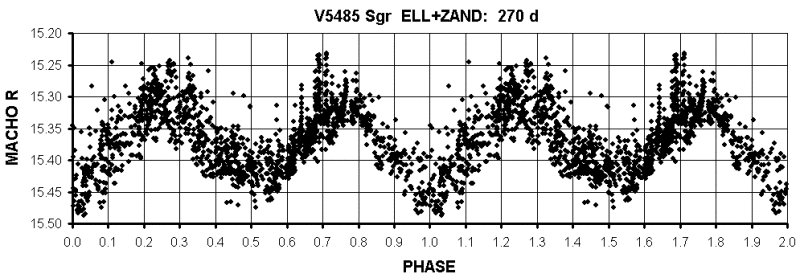"Peremennye Zvezdy",
Prilozhenie,
vol. 9, N 13 (2009)
Prilozhenie,
vol. 9, N 13 (2009)
V5485 Sagittarii: A Possible Symbiotic Star Exhibiting Ellipsoidal Variation Evidence as Orbital Signature
J. Greaves
Northants, England, UK
Received: 26.03.2009; accepted: 3.06.2009
(E-mail for contact: bydra@safe-mail.net)
| ||||||||||||||||||||||
Remarks: |
| During cross matching of objects from the Chandra Source Catalogue
with data for Baade's Window from the MACHO photometric database (Allsman and Axelrod
2001) the connection between several of these xray sources and some red giant stars
came to light, red giant stars not normally being so associated.
One such star is V5845 Sagittarius from GCVS Name List 78 (Kazarovets et al. 2006) classified in Glass and Schultheis (2002) as a semiregular variable having a regular 135.5 day period as part of their study of M giant stars discovered in Baade's Window by Blanco (1986). Examination of the MACHO epoch photometry for this object revealed that the apparent regularity of the period was due to rather than the star being a semiregular variable it in fact being an ellipsoidal variable with roughly twice the period, 270 days, superposed with what look to be some occasional small scale low amplitude erratic variation ("flickering") in the mean phased lightcurve. The Chandra data indicated that the associated xrays source is a hard source, which is suggestive of the star being a possible Symbiotic Star, with the xrays coming from a white dwarf companion. A literature search reveals that this suspicion and Chandra xray source association had already been noted in a Chandra correlation of ChaMPlane xray sources and Baade's Window M giants by van den Berg et al. (2006), their star BW3, wherein stars not traditionally diagnosable as Symbiotic Stars nevertheless are shown to present evidence of mass outflow (strong stellar wind) in their near infrared spectra with the interaction of this with a probable white dwarf companion resulting in the hard xray signature. In combination with the MACHO photometry evidenced ellipsoidal signature being responsible for the photometric variation and thus indicating an orbital modulation of the variability, the above leads to the conclusion that V5485 Sagittarii is a Symbiotic Star like red giant plus white dwarf pair with an orbital period of around 270 days and an optical amplitude of 0.2 to 0.3 magnitudes. Symbiotic Star Variables usually have orbital periods in the several hundred to thousand day plus range, and any clean photometric signature of such is usually lost within pulsational variation exhibited by the red giant, or more strongly evidenced by higher amplitude long duration eclipses. However, the period, ellipsoidal signature with superposed small scale flickering, and amplitude, of this star's phased lightcurve does have some strong similarities to one well known red giant and white dwarf binary, the 227 day orbital period and approximately 0.3 magnitude amplitude T Coronæ Borealis (e.g. Figure 2 in Zamanov and Zamanova 1997). Acknowledgements: This paper utilizes public domain data originally obtained by the MACHO Project, whose work was performed under the joint auspices of the U.S. Department of Energy, National Nuclear Security Administration by the University of California, Lawrence Livermore National Laboratory under contract No. W-7405-Eng-48, the National Science Foundation through the Center for Particle Astrophysics of the University of California under cooperative agreement AST-8809616, and the Mount Stromlo and Siding Spring Observatory, part of the Australian National University. This research has made use of data obtained from the Chandra Source Catalog, provided by the Chandra X-ray Center (CXC) as part of the Chandra Data Archive The Harvard Astrophysical Data Services' Abstract and Articles Service, and the CDS Strasbourg's SIMBAD service were also used in the researching of this object. |
| References: |
| Allsman, R.A., Axelrod T.S., 2001, arXiv:astro-ph/0108444v1
Blanco, V.M, 1986, Astron. J., 91, 290 Glass I.S., Schultheis M., 2002, MNRAS, 337, 519 Kazarovets E.V., Samus N.N., Durlevich O.V., Kireeva N.N., Pastukhova E.N, 2006, IBVS, No. 5721 van den Berg, M., Grindlay, J., Laycock, S., et al., 2006, Astrophys. J., 647, L135 Zamanov, R.K., Zamanova, V.I., 1997, IBVS, No. 4461 |
Light Curve
MACHO R band photometric data folded upon a period of 270 days showing both minima for the ellipsoidal variation. Data Source |